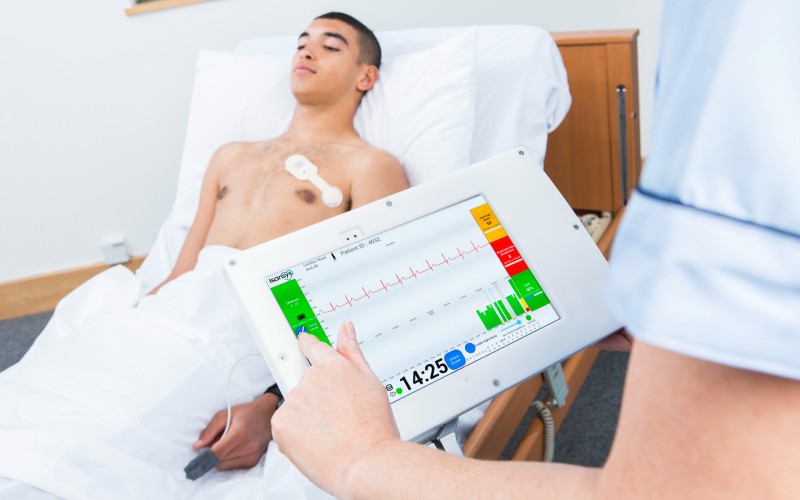In a medical emergency, the perceived wisdom is that a hospital is the safest place to be.
That is certainly true in many cases, as patients have access to specialist equipment, medical expertise and medicines. In other cases, however, the opposite may be true.
Keith Errey (below) and Rebecca Weir founded Isansys Lifecare – eighth on our MedTech 50 ranking – in 2010 with the aim of putting wireless monitoring systems and data-driven decision-making into the hands of clinicians. The Abingdon-based company’s connected technologies allow for the remote monitoring of patients at home and elsewhere.
“We want every patient to be monitored, connected and, therefore, safe,” CEO Errey tells BusinessCloud. “Because patients aren’t safe.
“It’s horrifying, but when Rebecca and I started out on this journey, around 10,000 people a year died of avoidable deaths in UK hospitals. They didn’t have to die; something went wrong, nobody noticed and they just died.
“Last year, 10,000 people died of avoidable deaths in UK hospitals. No difference – things haven’t moved fast enough.”
Vital signs observation is key to avoiding deterioration, cardiac arrest and death. However, with the exception of those staying in intensive care wards, not all patients are adequately monitored due to a range of factors including a lack of suitable beds and nursing resource.
Patients in general wards are monitored at long intervals – up to every eight hours – during which time the patient’s status could change significantly.
Patient Status Engine
Isansys’s Patient Status Engine (PSE) is an advanced remote patient monitoring platform combining wearable sensors, wireless connectivity, predictive AI analytics, dashboards and alerting for hospital, home and community settings.
“Imagine if an intensive care set-up was miniaturised and connected wirelessly to a small computer by the bedside. That’s what we’ve done,” Errey says of Isansys’s product. “The kind of information that we’re collecting is very high resolution with high accuracy, equivalent to that coming off a patient in an intensive care ward.
“There’s no need for people to be in hospital just for close observation and monitoring – it can be done at home. And the patient can move: movement is very, very important in any recovery process.”
Isansys Lifecare – Every patient monitored, connected and safe
The Patient Status Engine has the clinically validated NHS predictive algorithm – NEWS, or National Early Warning Score 2 – built into it.
“The data in our platform is put into the cloud and has algorithms applied to it which gives early warning scores or predictive indicators to care teams,” explains Errey.
“They can intervene hours – sometimes days – before something really bad happens to a patient.”
Errey will join fellow health technology entrepreneurs on a BusinessCloud panel at pro-manchester’s HealthTech conference 2022 on Friday 9th December – click below to register, using the discount code BusinessCloud20 for 20% off the ticket price
HealthTech Conference 2022 – data innovation in medicine & healthcare
Tailored apps
Apps focused on a variety of areas run in the PSE. “Some are pre-built by us, some are made by the client,” says Errey. “A digital diagnostic for a cardiac patient may collect the same data from our platform as, say, a hepatology patient with advanced liver disease; but the way it’s cut and spliced and analysed is completely different.
“It is very specific, which is why we don’t try to build all of them ourselves. There would be too many, and it takes a long time to get clinical validation. The best people to do that are those that are working in the clinic every day.”
Errey and Weir have been selling the potential for ‘virtual wards’ – where people can be monitored and treated away from a clinical setting – for a decade. It took a global pandemic to persuade the healthcare industry of its real value.
“COVID has totally changed the game,” says Errey. “Everybody now understands that a hospital isn’t a safe place to be. About a quarter of all COVID infections in the UK happened in and around hospitals.
“The NHS now has a clear objective of creating 20,000 ‘virtual beds’ within the next two years. That’s quite a big undertaking, so we’re benefiting from some of that at the moment.”
MedTech 50 – UK’s most innovative medical technology creators for 2022
Saving lives
Isansys is now fundraising as it eyes rapid commercial development in 2023. “We’ve built the products, put the regulatory approvals in place and built the internal systems to support growth. It’s very scalable: we just need to sell it,” says Errey.
He feels that many of those 10,000 annual UK deaths can be avoided if they are successful. “If our technology had been widely adopted, it would have made a big difference. So we’re not going to give up: we’re going to keep hammering away at this,” he says.
Isansys is working with healthcare organisations in Great Britain, Germany, Norway, Denmark, India, Singapore and the USA thanks to the dedication of the founders and their team.
Isansys Lifecare’s remote patient monitoring tech debuts in India
“It’s only through crazy entrepreneurs like me and the other people I know who beat on doors and work hard for decades that these things happen,” he explains. “Big companies can’t do it because things are always changing: how long does the CEO last at the top of a big company? Five years, seven years maybe.
“Then a successor comes in, looks at a project like this and decides to can it. You don’t have this long-term, crazy, driven focus on making these things happen in those companies.”


